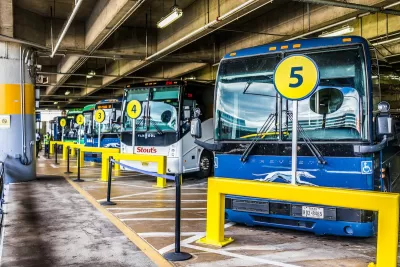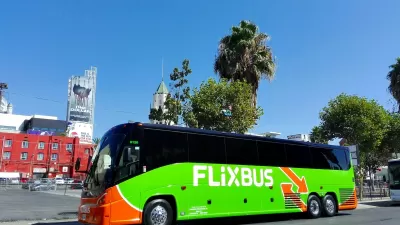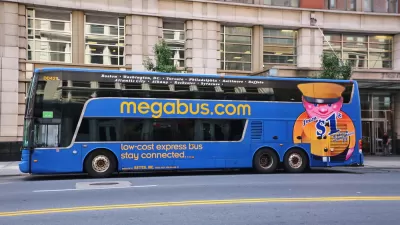Facing financial troubles, intercity bus operators are leaving passengers stranded without services in many U.S. markets.

The downward spiral for intercity bus service continues months after Coach USA, one of the nation’s biggest operators, filed for bankruptcy. Shortly after, Megabus announced it would suspend service in many of its markets, leaving passengers in a lurch.
In a piece for Streetsblog USA, Aaron Short outlines the history of modern intercity bus service and its struggle to maintain service after the pandemic, as well as its impacts on passengers who depend on it.
The disruption is the latest blow to a long-overlooked segment of the transportation sector that has failed to recover since the pandemic, been picked apart by private equity, and received little assistance from federal and state governments.
Meanwhile, bus stations with amenities are shuttering around the country as Greyhound sells off its properties, forcing bus passengers to wait for buses on poorly lit sidewalks or parking lots with no access to restrooms, shelter, or ticket agents. Few cities, such as Washington, D.C., are actively supporting intercity bus service by providing space for buses at major transit stations.
But that isn’t the case for most cities. “In some parts of the country, Megabus’s absence could prompt people to purchase vehicles or lead to less travel for job opportunities, education, and health care.”
FULL STORY: New Crisis for Inter-City Customers As Megabus Goes Bust

Maui's Vacation Rental Debate Turns Ugly
Verbal attacks, misinformation campaigns and fistfights plague a high-stakes debate to convert thousands of vacation rentals into long-term housing.

Planetizen Federal Action Tracker
A weekly monitor of how Trump’s orders and actions are impacting planners and planning in America.

In Urban Planning, AI Prompting Could be the New Design Thinking
Creativity has long been key to great urban design. What if we see AI as our new creative partner?

Portland Raises Parking Fees to Pay for Street Maintenance
The city is struggling to bridge a massive budget gap at the Bureau of Transportation, which largely depleted its reserves during the Civd-19 pandemic.

Spokane Mayor Introduces Housing Reforms Package
Mayor Lisa Brown’s proposals include deferring or waiving some development fees to encourage more affordable housing development.

Houston Mayor Kills Another Bike Lane
The mayor rejected a proposed bike lane in the Montrose district in keeping with his pledge to maintain car lanes.
Urban Design for Planners 1: Software Tools
This six-course series explores essential urban design concepts using open source software and equips planners with the tools they need to participate fully in the urban design process.
Planning for Universal Design
Learn the tools for implementing Universal Design in planning regulations.
Gallatin County Department of Planning & Community Development
Heyer Gruel & Associates PA
JM Goldson LLC
City of Camden Redevelopment Agency
City of Astoria
Transportation Research & Education Center (TREC) at Portland State University
Jefferson Parish Government
Camden Redevelopment Agency
City of Claremont





























